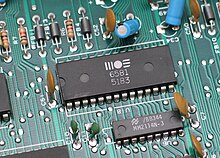Robert Yannes
Robert Yannes (* 1957 ) is an American engineer. He started his career as a hobby musician until he became a chip designer for MOS Technology , which had become part of the Commodore company . Al Charpentier hired Yannes particularly because of his keen understanding of music.
He developed the MicroPET with the help of Al Charpentier , which eventually led to the unintended prototype for the Commodore VC-20 computer . Yannes also influenced the design of the VIC (VC-20) video chip .
He then developed the SID synthesizer chip (6581). This chip had a sound resolution that was outstanding for the time, so that music could be played in high quality. The chip was also built into the Commodore C64 .
Soon after the work on the VC-20 was finished, Commodore began to work on the development of the successor VIC-40 , later renamed the C64 . Since the VIC-II graphics processor, which was being developed for the C64, no longer had a built-in tone generator and Yannes' enormous potential in the field of electronic sound generation had been recognized, he was exclusively entrusted with the development of a specialized sound chip for the new computer. The only limits that were set were a budget and a time limit, within which Yannes was allowed to realize himself undisturbed. Although the time frame was extremely tight , as is usual at Commodore under Jack Tramiel , Yannes managed to implement most of the features he had planned in the new chip. At the end of this development there was the chip, which became famous as the “Sound Interface Device” SID 6581, with sufficient power for high-quality and sonorous music production, which at the time was unparalleled not only in the computer sector.
Although Commodore had achieved a groundbreaking success with the C64, Jack Tramiel was dissatisfied with his engineers, because they had not been able to keep his schedule, which was objectively unrealistic. Instead of a bonus for the best-selling home computer in history, the developers involved received a salary cut, which led to massive resentments within the workforce. The result of this decidedly short-sighted and fatal decision for the company was the departure of most of the main developers of the C64 such as Charles Winterble , Al Charpentier and Robert Yannes.
After Yannes left MOS Technology , he founded Ensoniq in 1982 with other former MOS employees such as Bruce Crockett and Al Charpentier . For the first time, he was given the opportunity to design a sound chip entirely according to his own ideas, free of any restrictions from budgets or time limits. The result of this development, which is undoubtedly based on the experience with the SID 6581, was the Ensoniq 5503, which, through the use of multiplexing, which Yannes was not able to implement at SID due to time constraints, achieved 16 voices in stereo quality and 64 Kbytes of its own Memory contained. The 5503 was primarily used by Commodore's largest competitor in the Apple IIGS .
In January 1998 the Ensoniq Corp. by the sound card manufacturer Creative Technology Ltd. acquired for US $ 77 million and merged with E-mu Systems to form the company division E-Mu / Ensoniq.
Web links
- C64-Wiki.de article on Robert Yannes with a photo of him
Individual evidence
- ^ Andreas Varga: Interview with Bob Yannes. August 1996, archived from the original on February 22, 2007 ; Retrieved January 26, 2014 .
- ↑ http://stud1.tuwien.ac.at/~e9426444/yannes.html ( Memento from February 22, 2007 in the Internet Archive )
- ↑ Bagnall, Kretzinger, Forster: VolksComputer: Rise and Fall of the Computer Pioneer Commodore and the Birth of the PC Industry, ISBN 978-3-00-023848-2
| personal data | |
|---|---|
| SURNAME | Yannes, Robert |
| BRIEF DESCRIPTION | American engineer |
| DATE OF BIRTH | 1957 |
